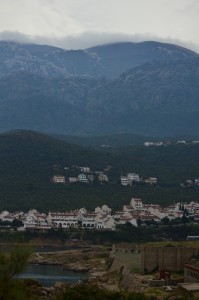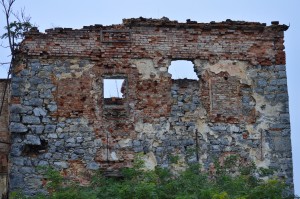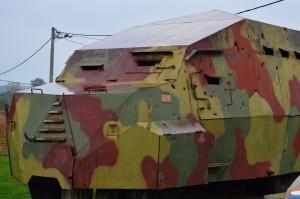Now that I’ve been back a whole week (gasp) from my extended trip through the wild country of what the Romans called Pannonia, Dacia, Dalmatia, Thrace, and Illyricum, along with a week in Rome, I’m still sorting through the thousands of images I took of the land and the sights.
So I thought I would record some of my impressions, particularly as they pertain to what’s coming up, not only for Gaius Porcinus and the next generation of the Marching With Caesar® series, but for the last part of Titus’ story, coming in November.
That book, Marching With Caesar®-Final Campaign, opens in modern-day Sisak, or Siscia, which is just 60 kilometers south of Zagreb. I regret to say that, although I was on a bus that took the southern ring road around Zagreb, that’s as close as I got to Sisak. I investigated the possibility of making a side trip to the town, but distances in that part of the world are deceiving; what is only a distance of 50 kilometers could take more than an hour to cover, even today.
Aquincum, more commonly known as Budapest, were the first Roman ruins that I encountered on this trip, and the civilian town is the part that is preserved and is open to the public. They were a tasty appetizer, but for a Romanophile like me, they did little more than whet the taste buds for more!
I was on an organized, Rick Steves tour for part of the trip, so I didn’t have a whole lot of latitude to go off exploring. We spent a night in Eger, Hungary, which from my calculations and with the help of the Barrington Atlas, was just a bit north of the eastern limes (of which Aquincum was a part) out on the great Hungarian Plain. But we were moving west; from Budapest we drove into Croatia, crossing the border at Gorican, and with every kilometer the country grew more rugged.
Driving southwest, deeper into Croatia, in the direction of the Plitzvice National Park, which is a UNESCO World Heritage Site because it is the first national park in Europe, I started to appreciate the ground. Speaking from a purely military point of view, it’s easy to see why people have been rebelling in this part of the world until as recently as 1995. In fact, I was “lucky” enough to experience Croatian Independence Day, in the tiny town of Rab, Croatia, on the island of the same name. (Here’s a note: Rab Island is a charming, lovely place. But you do NOT want to get stuck there when everything, and I mean EVERYTHING is closed) The land itself is made for an insurgency, and that holds as true for the days when men like Gaius Porcinus fought for Rome as it does today. Pocket valleys, steeply sloped ridges covered with fir trees, blind draws, all of these are perfect for a poorly equipped but highly motivated force to bring a better-trained, better-equipped force to a grinding halt. One thing I noted with interest; although the slopes and valleys are heavily forested, there isn’t very much undergrowth and shrubbery. In contrast to where I’m from, the Big Thicket of Texas is almost impenetrable because of the heavy undergrowth, but that’s not the case in Croatia, or at least the part that I saw. That means that, aside from the challenges posed by the sloping terrain, a lightly armed and mobile force can move fairly quickly from one point to another, while a more heavily equipped combatant, slowed by impediments like baggage trains will struggle with the land.
As I sat on the bus, watching the landscape slide by, aside from the temperature and the vegetation, it reminded me a great deal of the terrain of another place where men are trying to root out an entrenched insurgency, valley by valley and ridge by ridge. Because of its climate and elevation, Afghanistan is more inhospitable in terms of an environment, but mountains are mountains. And the mountains of Croatia, or Dalmatia as it was called back in the day, make this part of the world extremely rugged, and a nightmare to take and hold. Along the way to Plitzvice, in Karlovac, there is a roadside memorial containing a number of relic weapons. Included are a T-55 tank, an old WWII Sherman, and a couple of very interesting homemade APC’s, one of them based on a tractor. Surrounding the memorial are buildings that have been left in their wartime state, bombed out hulks complete with bullet holes, and across the road is a simple memorial, with all the names of the men and women of Karlovace who lost their lives in what is widely acknowledged to be one of the nastiest wars of the 20th century, which is saying something. In fact, the countryside is dotted with structures that haven’t been rebuilt, and as far as I could tell, there doesn’t seem to be any real rhyme or reason to what got rebuilt and what didn’t. There would be a row of prosperous-looking homes and small farms, flashing by in a blur through the bus window. Then suddenly there would be a blackened, burned-out hulk sliding by my window seat, the roof caved in and rubble strewn about, only to be replaced just as quickly by buildings that have been repaired and renovated. Compounding the mood, we had left the brilliant blue skies behind in Budapest, and would be more or less in the wet for the rest of the trip, still another week.
Which brings me to the other realization that hit me on this trip. For some time I’ve been really curious as to why the Roman campaign season traditionally ended at the end of September (and yes, I know there were exceptions to this). Now I know why. Granted, this is supposed to be an early and cold winter, but very quickly what had been a pleasant climate; cool in the day, colder at night, but with a crispness to the air that I am still reveling in now that I live in a place with seasons, became a source of real misery. Tramping through Plitzvice Park, on groomed trails, with the appropriate modern foul-weather gear, it was brought home to me just how unpleasant it would have been if all you were wearing was a woolen tunic, with a sagum thrown over. It would be a cold, wet and miserable experience, and when coupled with the terrain, it now makes sense to me why the Romans started to hunker down for the winter, particularly here.
This is a country made for warfare, a fact which has unfortunately been borne out over the centuries. And first Titus, then Gaius will be faced with that fact as they continue Marching With Caesar®.



